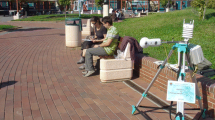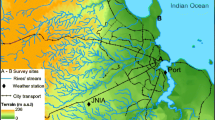Abstract
Outdoor urban areas are very important for cities and microclimate is a critical parameter in the design process, contributing to thermal comfort which is important for urban developments. The research presented in this paper is part of extensive field surveys conducted in Athens aimed at investigating people’s thermal sensation in a Mediterranean city. Based on 2313 questionnaires and microclimatic data the current work focuses on the relative frequencies of people’s evaluation of the thermal along with the sun and wind sensations between two seasons trying to identify the seasonal differences in thermal sensation. The impact of basic meteorological factors on thermal discomfort with respect to season are also examined, as well as the use of the outdoor environment. Results show that psychological adaptation is an important contributing factor influencing perception of the thermal environment between seasons. In addition, the thermal sensation votes during the cool months show that individuals are satisfied to a great extend with the thermal environment whereas the combination of high air temperature, strong solar radiation and weak wind lead to thermal discomfort during summertime. As far as the appropriate urban design in the Mediterranean climate is concerned, priority should be given to the warm months of the year.

















Similar content being viewed by others
References
Ahmed KS (2003) Comfort in urban spaces: defining the boundaries of outdoor thermal comfort for the tropical urban environments. Energy and Buildings 35:103–110
Ali-Toudert F, Mayer H (2006) Numerical study on the effects of aspect ratio and orientation of an urban street canyon on outdoor thermal comfort in hot and dry climate. Build Environ 41:94108
ASHRAE (1966) Thermal comfort conditions. ASHRAE standards. ASHRAE, New York, pp 55–66
Charalampopoulos I, Tsiros I, Matzarakis A, Chronopoulou A (2012) Analysis of the thermal Bioclimate in various urban configurations in Athens, Greece. Urban Ecosystems 16(2):217–233
Charalampopoulos I, Tsiros I, Chronopoulou A, Matzarakis A (2014) A note on the evolution of the daily pattern of thermal comfort-related micrometeorological parameters in small urban sites in Athens. Int J Biometeorol
Chen L, Ng E (2012) Outdoor thermal comfort and outdoor activities: a review of research in the past decade. Cities 29:118–125
Cheng V, Ng E, Chan C, Givoni B (2012) Outdoor thermal comfort study in sub-tropical climate: a longitudinal study based in Hong Kong. Int J Biometeorol 56(1):43–56
Declet-Barreto J, Brazel AJ, Martin CA, Chow WT, Harlan SL (2013) Creating the park cool island in an inner-city neighborhood: heat mitigation strategy for phoenix, AZ. Urban Ecosystems 16(3):617–635
Emmanuel R, Rosenlund H, Johansson E (2007) Urban shading – a design option for the tropics? A study in Colombo, Sri Lanka. Int J Climatol 27:1995–2004
Fanger PO (1970) Thermal Cofort. Danish Technical Press, Copenhagen
Fanger PO (1973) Assessment of man’s thermal comfort in practice. Br J Ind Med 30(4):313–324
Hoppe P (1984) Die Energiebilanz des Menschen. University of Munich. (in German)
Hoppe P (1993) Heat balance modelling. Experientia 49:741–746
Hoppe P (1999) The physiological equivalent temperature—a universal index for the biometeorological assessment of the thermal environment. Int J Biometeorol 43:71–75
Johansson E, Yahia MW (2011) Subjective Thermal Comfort in Urban Spaces in the Warm-humid City of Guayaquil, Ecuador. PLEA 2011 - 27th Conference on Passive and Low Energy Architecture, Louvain-la- Neuve, Belgium, 13–15 July
Kántor N, Unger J (2010) Benefits and opportunities of adopting GIS in thermal comfort studies in resting places: an urban park as an example. Landsc Urban Plan 98(1):36–46
Kántor N, Kovács A, Takács Á (2016) Seasonal differences in the subjective assessment of outdoor thermal conditions and the impact of analysis techniques on the obtained results. Int J Biometeorol 1–21
Knez I, Thorsson S (2006) Influences of culture and environmental attitude on thermal, emotional and perceptual evaluations of a Public Square. Int J Biometeorol 50:258–268
Krüger E, Drach P, Emmanuel R, Corbella O (2013) Assessment of daytimeoutdoor comfort levels in and outside the urban area of Glasgow. UK Int J Biometeorol 57:521–533
Lenzholzer S (2010) Engrained experience—a comparison of microclimate perception schemata and microclimate measurements in Dutch urban squares. Int J Biometeorol 54(2):141–150
Lin TP (2009) Thermal perception, adaptation and attendance in Public Square in hot and humid regions. Build Environ 44:2017–2026
Matzarakis A (2000) Assessing climate for tourism purposes: existing methods and tools for the thermal complex. University of Freiburg
Matzarakis A, Mayer H (1997) Heat stress in Greece. Int J Biometeorol 41:34–39
Matzarakis A, Mayer H, Iziomon MG (1999) Applications of a universal thermal index: physiological equivalent temperature. Int J Biometeorol 43:76–84
Matzarakis A, Rutz F, Mayer H (2007) Modeling radiation fluxes in simple and complex environments—application of the RayMan model. Int J Biometeorol 51:323–334
Matzarakis A, Rutz F, Mayer H (2010) Modelling radiation fluxes in simple and complex environments—basics of the RayMan model. Int J Biometeorol 54:131–139
Mayer H, Hoppe P (1987) Thermal comfort of man in different urban environments. Theor Appl Climatol 38:43–49
Nastos PT, Matzarakis A (2013) Human bioclimatic conditions, trends, and variability in the Athens University campus, Greece. Adv Meteorol 2013:8
Nikolopoulou M (2011) Outdoor thermal comfort. Front Biosci 3:1552–1568
Nikolopoulou M, Lykoudis S (2006) Thermal comfort in outdoor urban spaces: analysis across different European countries. Build Environ 41(11):1455–1470
Nikolopoulou M, Lykoudis S (2007) Use of outdoor spaces and microclimate in a Mediterranean urban area. Build Environ 42:3691–3707
Nikolopoulou M, Steemers K (2003) Thermal comfort and psychological adaptation as a guide for designing urban spaces. Energy and Buildings 35:95–101
Nikolopoulou M, Baker N, Steemers K (1999) Thermal comfort in urban spaces: different forms of adaptation. Proceedings of the REBUILD 1999 on Shaping Our Cities for the twenty-first Century, Barcelona
Nikolopoulou M, Baker N, Steemers K (2001) Thermal comfort in outdoor urban spaces: understanding the human parameter. Sol Energy 70(3):227–235
Oliveira S, Andrade H (2007) An initial assessment of the bioclimatic comfort in an outdoor public space in Lisbon. Int J Biometeorol 52:69–84. doi:10.1007/s00484-007-0100-0
Pantavou K, Theoharatos G, Santamouris M, Asimakopoulos D (2013) Outdoor thermal sensation of pedestrians in a Mediterranean climate and a comparison with UTCI. Build Environ 66:82–95
Parsons KC (2003) Human thermal environments: the effects of hot, moderate and cold environments on human health, comfort and performance, 2nd edn. Taylor and Francis, New York
Pearlmutter D, Jiao D, Garb Y (2014) The relationship between bioclimatic thermal stress and subjective thermal sensation in pedestrian spaces. Int J Biometeorol 58(10):2111–2127
Rupp RF, Vásquez NG, Lamberts R (2015) A review of human thermal comfort in the built environment. Energy and Buildings 105:178–205
Santamouris M, Papanikolaou N, Koronakis I, Livada I, Asimakopoulos D (1999) Thermal and air flow characteristics in a deep pedestrian canyon under hot weather conditions. Atm Environ 33:4503–4521
Shashua-Bar L, Tsiros I, Hoffman ME (2012) Passive cooling design options to ameliorate thermal comfort in urban streets of a Mediterranean climate (Athens) under hot summer conditions. Build Environ 57:110–119
Spagnolo J, De Dear R (2003) A field study of thermal comfort in outdoor and semi-outdoor environments in subtropical Sydney Australia. Build Environ 38(5):721–738
Tseliou A, Tsiros IX (2016) Modeling urban microclimate to ameliorate thermal sensation conditions in outdoor areas in Athens (Greece). Build Simul 9(3):251–267
Tseliou A, Tsiros IX, Nikolopoulou M, Psyloglou V, Lykoudis S (2013) Aspects of human thermal preferences in the urban outdoor environment of Athens: a priliminary study. Proceedings of the 13th International Conference of Environmental Science and Technology Athens, Greece, September 5–7
Tseliou A, Tsiros IX, Nikolopoulou M, Papadopoulos G (2015) Outdoor thermal sensation in a Mediterranean climate (Athens): the effect of selected microclimatic parameters. Archit Sci Rev 1–13
Tsiros IX, Hoffman ME (2014) Thermal and comfort conditions in a semi-closed rear wooded garden and its adjacent semi-open spaces in a Mediterranean climate (Athens) during summer. Archit Sci Rev 57(1):63–82
Vanos JK, Warland JS, Gillespie TJ, Kenny NA (2010) Review of the physiology of human thermal comfort while exercising in urban landscapes and implications for bioclimatic design. Int J Biometeorol 54(4):319–334
Yahia MW, Johansson E (2012) Evaluating the behavior of different thermal indices by investigating various outdoor urban environments in the hot dry city of Damascus, Syria. Int J Biometeorol 57(4):615–663
Yang W, Wong NH, Jusuf SK (2013) Thermal comfort in outdoor urban spaces in Singapore. Build Environ 59:426–435
Acknowledgements
The authors thank the four reviewers for their comments and helpful suggestions.
Author information
Authors and Affiliations
Corresponding author
Rights and permissions
About this article
Cite this article
Tseliou, A., Tsiros, I.X. & Nikolopoulou, M. Seasonal differences in thermal sensation in the outdoor urban environment of Mediterranean climates – the example of Athens, Greece. Int J Biometeorol 61, 1191–1208 (2017). https://doi.org/10.1007/s00484-016-1298-5
Received:
Revised:
Accepted:
Published:
Issue Date:
DOI: https://doi.org/10.1007/s00484-016-1298-5




